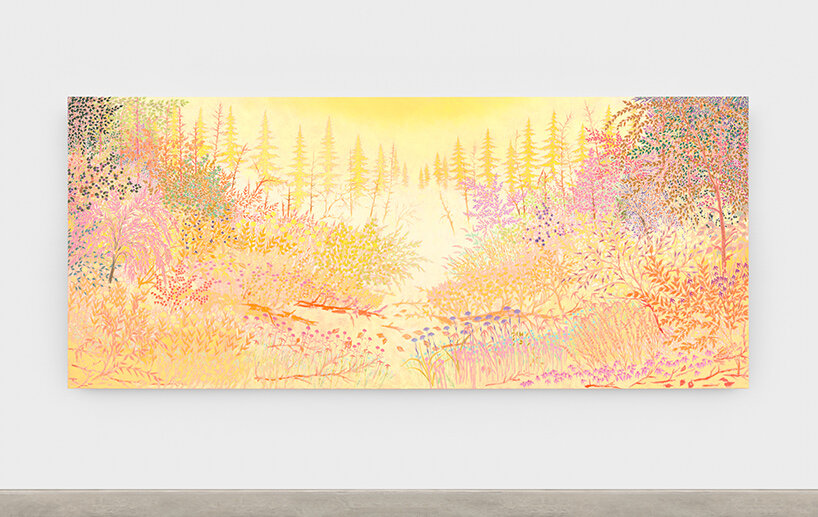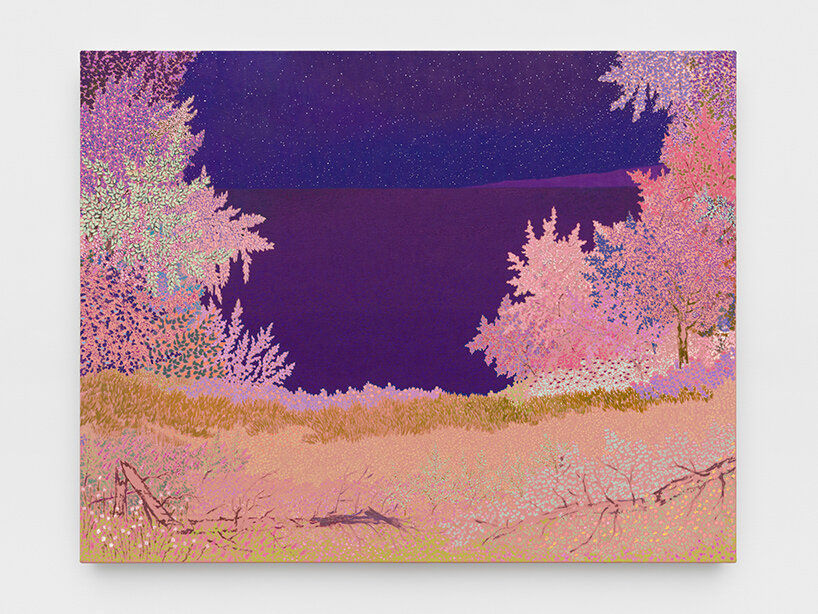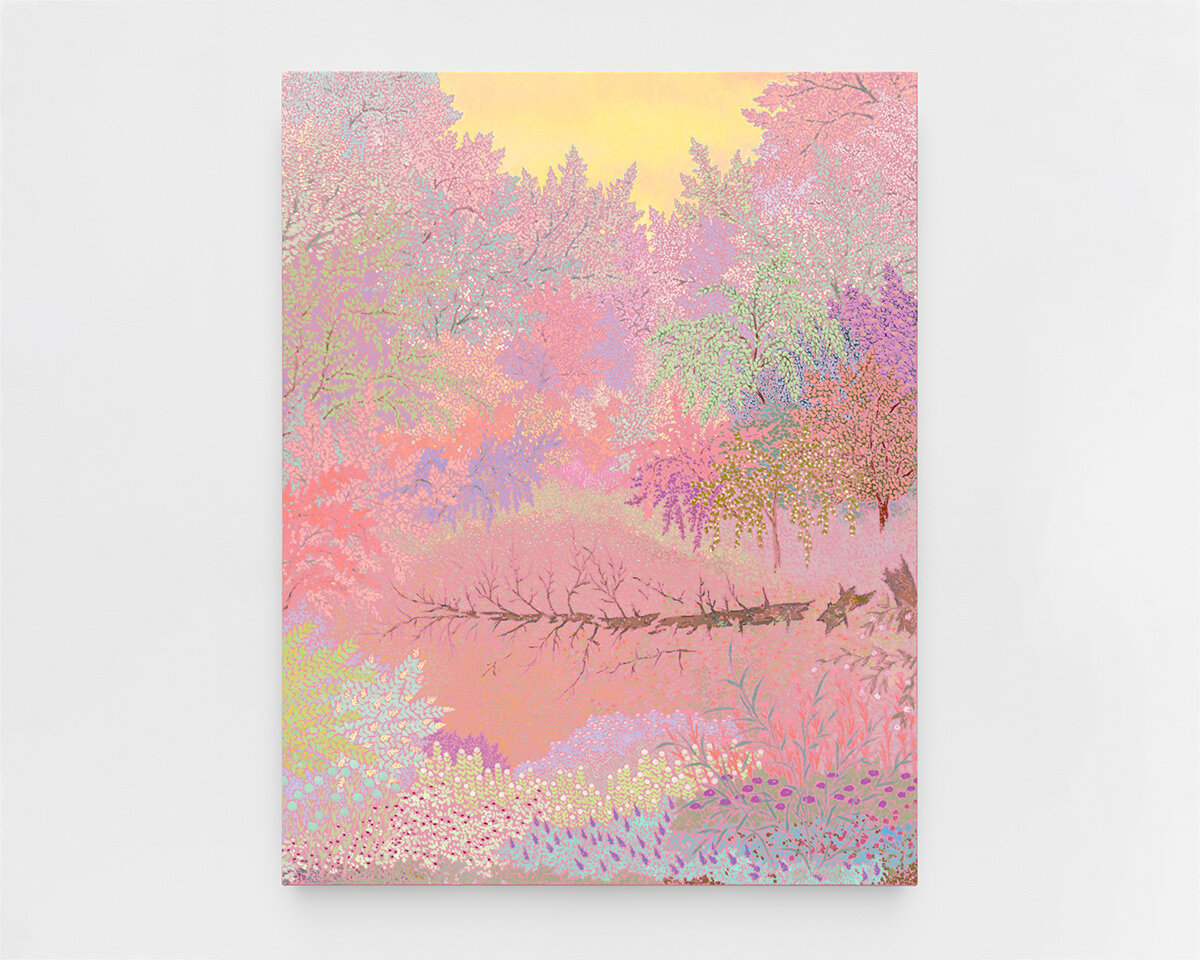‘sometimes splendid seeming…stellar even…ripping’
Artist John McAllister’s latest exhibition, sometimes splendid seeming…stellar even…ripping, at James Fuentes’ Los Angeles gallery, invites viewers to explore the temporal and symbolic cycles of nature through his intricate landscape and playful still-life paintings. Inspired by his ritual bike rides around his home in Florence, Massachusetts, McAllister captures the fleeting moments in nature, from decaying winters and blossoming springs. Each piece is born from a close observation of the natural world, its landscapes backdropped by glimmering sunsets and skies speckled with stars. John McAllister‘s show, sometimes splendid seeming…stellar even…ripping, is on view at James Fuentes gallery in Los Angeles from April 13th — June 1st, 2024.
The artist’s paintings are characterized by their exaggerated palettes and intricate details, shaping dense patterns of leaves, petals, and branches. His work spans the personal and universal, blending the linear progression of human life with the cyclical patterns of nature. This duality is further explored in his still-life compositions, where domestic scenes are contrasted with abstract depictions of nature to pair wilderness with the human-made environment. designboom spoke with McAllister to learn more about the themes and inspirations behind his work — read the full interview with the artist below!

John McAllister, beacon beaming tumult teaming chorus clamour, 2024
a dialogue with John McAllister
designboom (DB): Can you describe the inspiration behind the title ‘sometimes splendid seeming…stellar even…ripping’ for your current exhibition?
John McAllister (JM): The ‘sometimes’ in the title alludes to the temporary nature of the moments within these paintings, while simultaneously being a mundane, everyday word to take down the loftiness. ‘Splendid seeming’ refers to the reality that existence is always unusual, it just seems more so with these moments of grandeur in a landscape such as spectacular sunsets or the uprising of spring.
‘Stellar’ because being out in nature and then back in the studio thinking about what I saw reminds me that we are on a giant rock floating in space and also it is often used as a superlative adjective. ‘Ripping’ is a more exciting and abrasive way of saying excellent. The title needed to conclude with something jarring to even out its floral quality.
 John McAllister, serenest rave ring out, 2024
John McAllister, serenest rave ring out, 2024
DB: Your paintings are said to capture the temporal and symbolic cycles of nature. How do your ritual bike rides influence the themes and compositions of your work?
JM: I often begin a bike ride at sunrise and conclude it at sunset, doing this throughout every season. It cultivates a keen awareness of the changing world. You, the rider, become like the hands of a clock, circling the Earth’s dial. The light’s unique qualities shift as our position in the solar system changes. Spring unfolds slowly as days lengthen, bursting with an initial explosion of color before morphing into a verdant tapestry. Those spectacular, chromatic sunsets then recede further into the distance.
As days shorten, the polar hues creeping closer at dawn and dusk compress the vibrant middle portion of the day. It becomes stark, almost black and white, making it hard to believe greens, pinks, and purples are even possible. Then, just as suddenly, the sunset delivers them with an overwhelming flourish. The landscape itself often presents prosceniums, natural stages, urging you to stop and fully take it in.
 John McAllister, fathoms found sounds abound, 2024
John McAllister, fathoms found sounds abound, 2024
DB: How does your personal journey of understanding mortality in relation to your child and parents reflect in your landscapes and still-life paintings?
JM: The temporal qualities of seasons and days not only reinforce the impermanence of all things, but also constantly confront us with death, decay, and the ecstasy of rebirth. There’s a ceaseless cascade: dead trees, fallen leaves, decaying undergrowth, alongside deceased animals, newborn creatures, and spring flowers thriving on the decomposed remains of the fallen tree. I see my child springing into life as I decay. This cycle relentlessly unfolds everyday. Our human existence, I believe, is an extended version of these seasonal cycles. This is why I choose to show these moments of shifting nature.
 John McAllister, lullaby like hush hush, 2024
John McAllister, lullaby like hush hush, 2024
DB: Can you discuss your approach to color — with your exaggerated palette and shifting scale — and how it enhances the metaphorical aspects of your work?
JM: Most of the time, nature exists in a palette of greens, browns, and whites. However, when bursts of exaggerated color erupt, the experience becomes especially pronounced. It fills me with a sense of exuberance, excitement, and anticipation. I want to capture these same qualities in my paintings. I want them to be windows of possibility, to feel like a vibrant event. Ideally, my paintings embody both exuberance and fragility simultaneously.
 John McAllister, dawning late luxuriate, 2024
John McAllister, dawning late luxuriate, 2024
DB: It’s said that you make use of small brushes to create dense patterns across your canvases. What is your process for managing these detailed elements on a large scale?
JM: I’m a very methodical painter who appreciates the looseness found in some paintings. This seeming contradiction led me to develop a technique that allows me to achieve both qualities. I meticulously place each mark, starting from one side of the canvas and progressing systematically, almost like a printer. However, I achieve a loose effect by using small brushes. These brushes allow me to avoid the overt expressiveness often associated with a large brush and create the subtle, nuanced marks that I find echo the enigmatic qualities I observe in nature.
By ‘expressionistic,’ I mean a style that prioritizes the artist’s hand as the most prominent element. By ‘oracular,’ I mean that when I observe nature, I don’t necessarily see individual leaves; instead, I perceive a dense tapestry. This density is formed by countless individual elements, and I believe these carefully placed, yet somewhat rough and seemingly uncontrolled marks best represent this phenomenon, while also fulfilling my desire for control over the overall composition.
I’m particularly drawn to the experience of simultaneously looking ‘at’ and ‘into’ a painting. It’s the ability to appreciate both the surface and the feeling of peering through a window into a deeper world. This approach to painting, for me, embodies this relationship in the most satisfying way.

John McAllister, revel late merry make (detail), 2024
DB: How does René Descartes’ exploration of light and perception influence your artistic practice, especially in how you represent the interaction between natural and human-made elements?
JM: René Descartes doesn’t influence my artistic practice itself. However, he does influence my attempts to explain it afterwards. Painting, for me, is an elaborate way of explaining myself nonverbally. I’ve spent decades doing this. However, I’m often asked to re-explain myself and my work in words, which is what I’m doing right now, for instance. That’s when I encounter more eloquent and thoughtful thinkers with a gift for language. I then crudely attempt to use their ideas to shed light on the nonverbal explanation that occupies most of my time.
 John McAllister, some jaunts merry made, 2024
John McAllister, some jaunts merry made, 2024
JM (continued): There’s a particular snippet of text I often recall, though I can’t be certain of its author, philosopher or otherwise. This snippet plays an outsized role in how I explain myself. It’s the idea of ‘having at a glance,’ which I, perhaps mistakenly, attribute to Descartes. The key takeaway for me, a non-philosopher, is how this concept suggests that all images, light, and the entire seen world reside within our minds. They are what we have ‘at a glance.’ This means that when we see the stars, the sun, the refraction of snow in a sunset, or even a Bonnard painting across the room, the image itself is being formed within us.
Through our eyes and the process of translating all that information, we ‘have’ that image in our minds. I find this incredibly exciting. When a painting, with its remarkable ability to translate very low-resolution and abbreviated marks into an experience that represents nature, participates in this process, it becomes all the more enjoyable to be aware of it happening.

John McAllister, darksome night bright beaming, 2024
DB: In your still-life paintings, you depict calm domestic scenes with views of abstracted nature. What do you aim to convey through these contrasts?
JM: I love how overt you can be with symbolism in still life paintings. A watch represents time slipping away. Flowers explain all the excessive beautiful fragility of life. A half drunk tropical cocktail shows decadence and leisure. Decoration inside can be the stand in for a beauty outside. Paintings on walls and bouquets bring nature inside without all the mosquitoes and weather. My indoor life is not as exciting as my still life makes it seem. I paint in a white box and live in a more sober surrounding. These show a decadent life I would like to lead.

John McAllister, fathoms found sounds abound (detail), 2024
DB: The panorama ‘beacon beaming tumult teaming chorus clamour’ is said to suggest ‘the imperceptibility of looming chaos when beholding an instance of natural beauty.’ How do you balance these opposing forces within a single composition?
JM: The nearby fire, illuminating the landscape in a ‘beacon beaming tumult teaming chorus clamour,’ embodies a duality. It simultaneously destroys everything in its path while revealing the full beauty of the scene. The flowers and leaves, competing for attention with their elaborate displays, will all become mere fuel for the flames. This scenario is a dramatic microcosm of nature’s ever-present theme: delicate beauty juxtaposed with raw violence. Here, however, it unfolds in an instant rather than over eons.

John McAllister, beacon beaming tumult teaming chorus clamour (detail), 2024
JM (continued): Fires in nature are as much a force of regeneration as they are destruction. They create scenes of both immense power and breathtaking beauty. These fires remind us that even what appears most stable is ultimately delicate and can vanish in an instant. While flowers may not evoke death in me, I’m constantly aware of their fleeting nature. Nature, like fire with its untamed light and boundless energy, possesses this quality of impermanence. It’s this very impermanence that fascinates me. Looking at a painting offers a fleeting moment of captivation, but I strive to capture these grander, more powerful themes, aiming to elevate that moment into something more spectacular.





project info:
exhibition title: sometimes splendid seeming…stellar even…ripping
artist: John McAllister | @j.o.h.n.mcallister
gallery: James Fuentes | @james_fuentes_llc
location: 5015 Melrose Avenue, Los Angeles, CA
on view: April 13th — June 1st, 2024
photography: © James Fuentes









